As our planet warms and weather patterns shift, gardeners everywhere face new challenges. Longer dry spells, water restrictions, and unpredictable rainfall are becoming the new normal. But there’s good news: drought-resistant gardening offers a sustainable solution that works even in limited spaces. This approach isn’t just about surviving water scarcity—it’s about creating beautiful, productive gardens that thrive with minimal resources.
Whether you have a small balcony, a modest backyard, or just a sunny windowsill, you can adapt your growing practices to be more resilient in the face of climate change. This guide will walk you through the essentials of drought-resistant gardening for small spaces, helping you grow fresh food and beautiful plants while conserving our most precious resource—water.
Why Drought-Resistant Gardening Matters Now
The stark contrast between traditional and drought-resistant gardens during dry periods
Climate Trends
Recent data from climate scientists paints a clear picture: global temperatures continue to rise, with the last decade being the warmest on record. This warming trend directly impacts precipitation patterns, creating longer dry periods interspersed with intense but less frequent rainfall events. In the United States alone, moderate to exceptional drought conditions affected over 40% of the country in recent years.
These shifts aren’t temporary anomalies—they represent our new gardening reality. As climate change accelerates, regions that once enjoyed reliable rainfall now experience unpredictable dry spells. Even traditionally water-rich areas face seasonal shortages and restrictions as demand increases and supplies become less reliable.
Urban Challenges
Urban gardeners face unique obstacles when it comes to drought-resistant gardening. Limited space often means fewer options for rainwater collection. Concrete and asphalt create heat islands that increase water evaporation rates. Many city dwellers contend with strict water usage regulations during dry periods, with some municipalities implementing tiered pricing that makes excessive watering prohibitively expensive.
Container gardens, which dominate urban growing spaces, typically dry out faster than in-ground plantings. Balconies and rooftop gardens may experience higher winds and temperatures, further increasing water loss. Despite these challenges, small-space gardening offers unique opportunities for water-efficient design.
Ready to make your garden more resilient?
Start by assessing your current water usage. Track how much water you use in your garden for one week to establish a baseline for improvement.
Benefits
Environmental Benefits
- Reduced water consumption preserves local supplies
- Less runoff means fewer pollutants entering waterways
- Native drought-resistant plants support local pollinators
- Lower energy usage for water pumping and treatment
Personal Benefits
- Lower water bills, especially during summer months
- Less maintenance time spent watering and managing plants
- More resilient gardens that survive vacation periods
- Stress reduction from knowing your garden can withstand dry spells
By embracing drought-resistant gardening techniques, you’re not just adapting to climate change—you’re actively participating in the solution. Water-smart gardens reduce pressure on municipal systems during peak demand and demonstrate sustainable practices to your community.
Drought-Resistant Plants for Small Spaces
The foundation of any water-smart garden is choosing the right plants. Drought-resistant species have evolved adaptations like deep root systems, waxy leaves, or water-storing tissues that help them thrive with minimal moisture. For small spaces, it’s essential to select plants that deliver maximum impact while staying compact.
Top 10 Drought-Resistant Plants for Small Spaces

Drought-resistant plants that thrive in containers and small garden spaces
Herbs
- Rosemary – Aromatic evergreen shrub that thrives in full sun and dry conditions
- Lavender – Fragrant perennial with silvery-green foliage and purple flower spikes
- Thyme – Low-growing herb perfect for containers and small spaces
Vegetables
- Bush Beans – Compact plants that produce well even during dry periods
- Cherry Tomatoes – Smaller varieties need less water than full-sized tomatoes
- Kale – Surprisingly drought-tolerant once established
Ornamentals
- Sedum – Succulent with star-shaped flowers in various colors
- Russian Sage – Produces lavender-blue flowers on silvery stems
- Yarrow – Flat-topped flower clusters in yellow, white, or pink
- Agave – Architectural succulent for dramatic focal points
When selecting plants, consider their mature size and growth habits. In small spaces, look for compact varieties or those that can be trained vertically. Group plants with similar water needs together to prevent overwatering some while underwatering others—a practice known as hydrozoning.
Vertical Gardening Tips
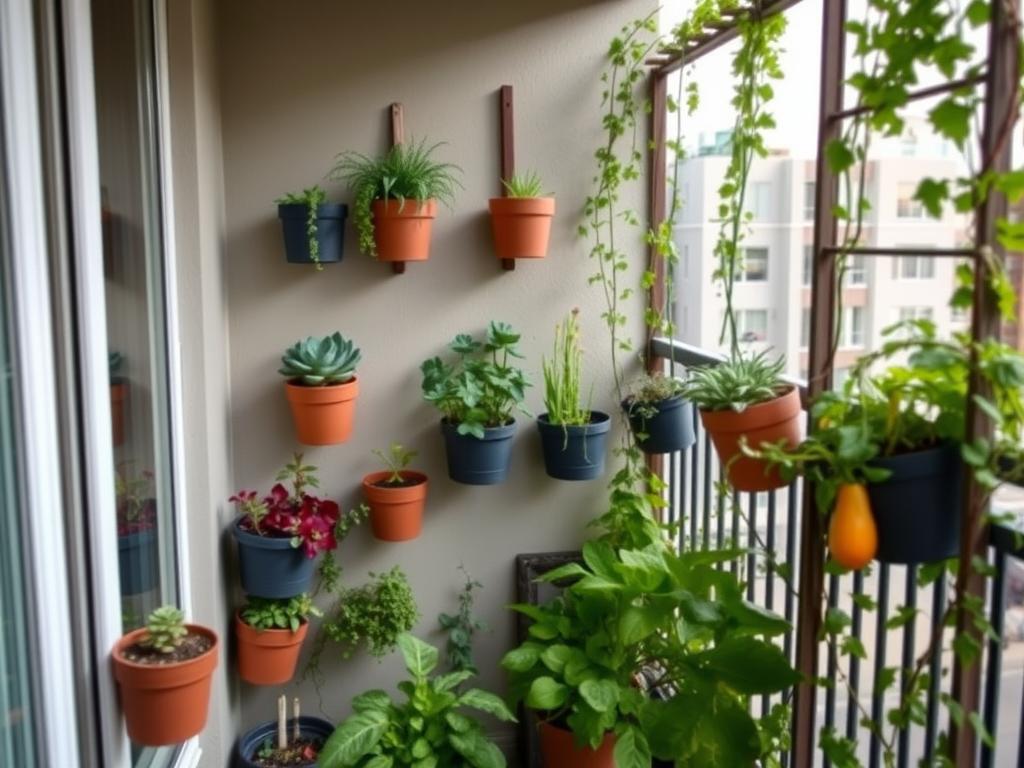
Maximizing small spaces with vertical drought-resistant gardening techniques
Vertical gardening is a game-changer for drought-resistant gardening in small spaces. By growing upward instead of outward, you can maximize your growing area while creating microclimates that help conserve moisture. Here are some effective vertical gardening strategies for drought-resistant plants:
Vertical Structures
- Trellises – Perfect for vining vegetables like cucumbers and beans
- Wall Planters – Create living walls with succulents and small herbs
- Hanging Baskets – Ideal for trailing plants like purslane or strawberries
- Tiered Planters – Maximize space while creating visual interest
Vertical Gardening Benefits
- Improved air circulation reduces fungal diseases
- Creates shade that helps retain soil moisture
- Makes efficient use of limited watering
- Easier to monitor plant health and water needs
- Provides natural cooling for adjacent living spaces
“Vertical gardening isn’t just space-efficient—it’s water-efficient too. When you water plants arranged vertically, the moisture trickles down from higher plants to lower ones, ensuring nothing goes to waste.”
Example Setup: Balcony Drought-Resistant Garden
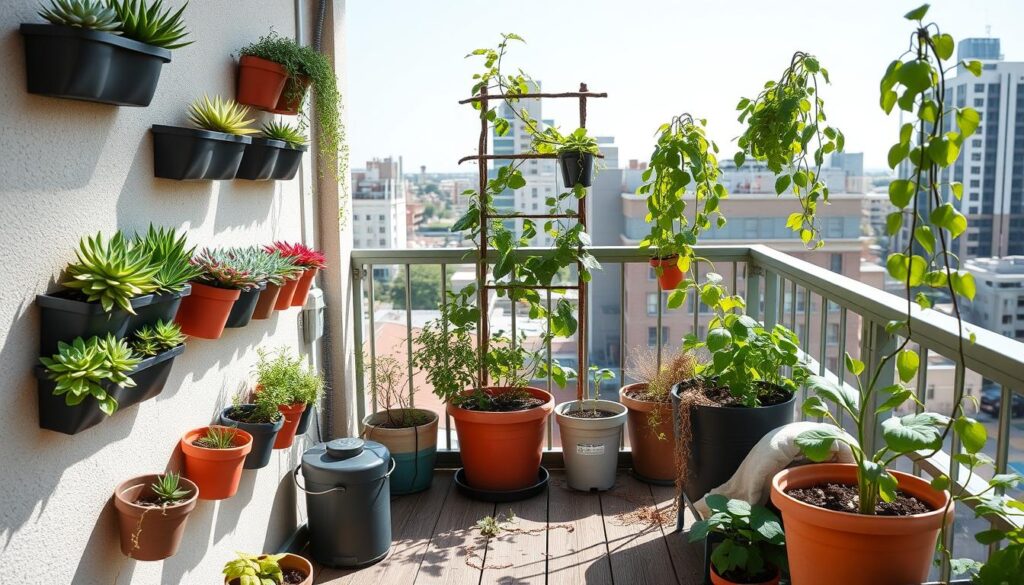
A complete drought-resistant balcony garden with vertical elements and water-saving features
Here’s how to transform a typical 6′ x 3′ balcony into a drought-resistant oasis:
| Zone | Plants | Container Type | Water-Saving Features |
| Railing | Trailing rosemary, thyme, purslane | Railing planters with water reservoirs | Self-watering reservoirs, mulch layer |
| Wall | Succulents, small sedums, hens and chicks | Pocket wall planter | Drip irrigation system, shade cloth during peak heat |
| Floor | Bush beans, compact peppers, dwarf lavender | 5-gallon fabric pots | Ollas (buried clay pots), coconut coir mixed with soil |
| Vertical Trellis | Cucumbers, small melons, climbing beans | Long rectangular planters | Wicking system, shade created by climbing plants |
Start Your Drought-Resistant Container Garden
Begin with just 2-3 drought-resistant plants in containers. Monitor their water needs and observe how they perform in your specific conditions before expanding.
Building Water-Smart Soil
The secret to successful drought-resistant gardening lies beneath the surface. Well-designed soil acts like a sponge, absorbing water when it’s available and releasing it slowly to plant roots. In small spaces, where every drop counts, optimizing your soil is especially important.
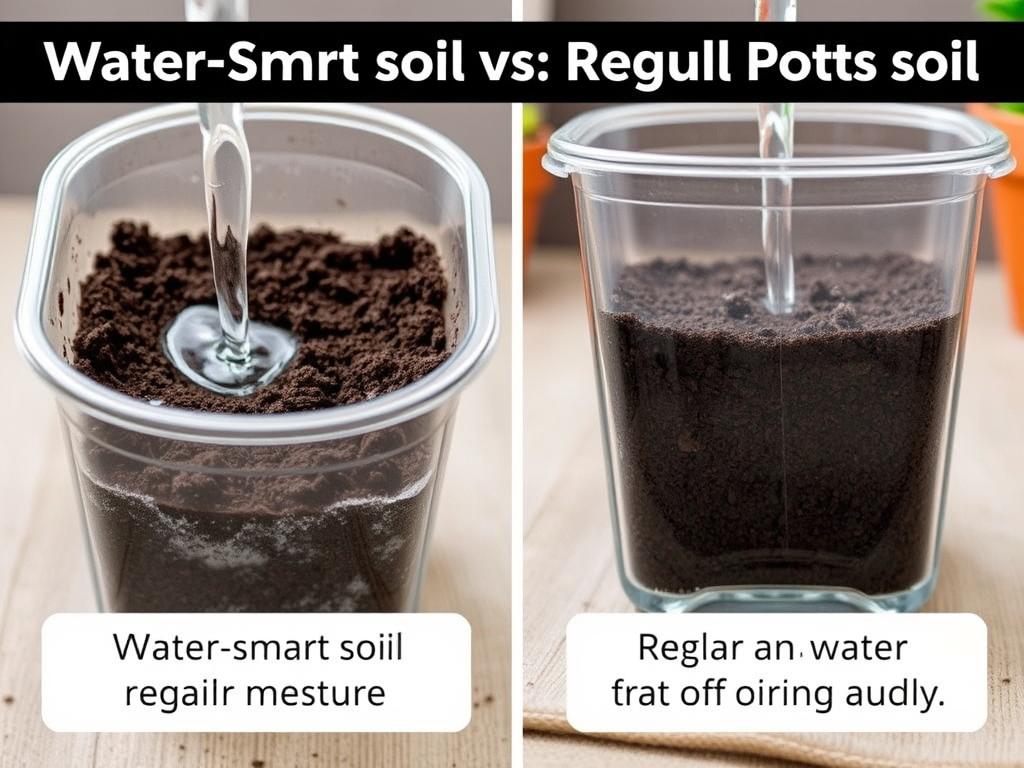
Water-smart soil (left) retains moisture much longer than standard potting soil (right)
Soil Amendments
Transforming ordinary garden soil or potting mix into water-smart growing medium is straightforward with the right amendments. Here’s a step-by-step approach to creating drought-resistant soil for your small-space garden:
- Start with a high-quality potting mix as your base
- Add 30% coconut coir to improve water retention
- Mix in 10% worm castings for slow-release nutrients
- Incorporate 5% biochar to improve soil structure
- Add a small amount of mycorrhizal fungi to support root development
For Container Gardens
- Test soil pH and structure before amending
- Add 2-3 inches of compost and work into top 6 inches of soil
- Incorporate aged manure for slow-release nutrients
- Mix in leaf mold to improve water retention
- Consider adding a small amount of clay to sandy soils
For In-Ground Beds
- Create a 50/50 mix of topsoil and compost
- Add 10% vermiculite or perlite for drainage
- Incorporate 10% coconut coir for water retention
- Mix in a small amount of greensand for minerals
- Consider a layer of cardboard at the bottom to slow drainage
For Raised Beds
Pro Tip: Hydrogels (water-absorbing polymers) can be added to container soil to dramatically increase water retention. Just 1 teaspoon per gallon of soil can reduce watering frequency by up to 50%. Look for biodegradable options made from natural materials.
Once you’ve prepared your water-smart soil, maintain its moisture-retaining properties by adding a 2-3 inch layer of mulch on top. Organic mulches like straw, shredded leaves, or wood chips not only conserve moisture but also break down over time to add nutrients to the soil.
Rainwater Harvesting

A space-efficient rainwater harvesting system perfect for small gardens
Even in the smallest spaces, capturing rainwater can significantly reduce your reliance on municipal water supplies. Here’s how to set up a simple rainwater harvesting system for a small garden:
- Select a rain barrel – For small spaces, look for slim designs that fit against walls or in corners. A 50-gallon barrel can provide weeks of water for a modest container garden.
- Position near a downspout – If you have access to a roof downspout, position your barrel beneath it. For balconies without downspouts, consider a catchment tarp that funnels water into your barrel.
- Install a diverter – A downspout diverter allows you to direct the first flush of rain (which may contain roof debris) away from your barrel.
- Add a spigot and overflow valve – Install a spigot near the bottom for easy access to water and an overflow valve to prevent flooding during heavy rain.
- Cover with a fine mesh screen – This prevents debris and mosquitoes from entering your water supply.
For ultra-small spaces like balconies without access to downspouts, consider micro-harvesting techniques. Place shallow containers to catch rainfall directly, then transfer the collected water to a storage container. Even a few gallons of harvested rainwater can make a difference during dry periods.
Improve Your Soil Today
Start with just one container of water-smart soil. Compare plant performance and watering frequency with your regular soil to see the difference firsthand.
Irrigation Strategies
How you deliver water to your plants is just as important as how much you give them. Efficient irrigation systems minimize waste while ensuring plants receive moisture directly at their roots, where it’s most needed. For small-space gardens, precision is key.
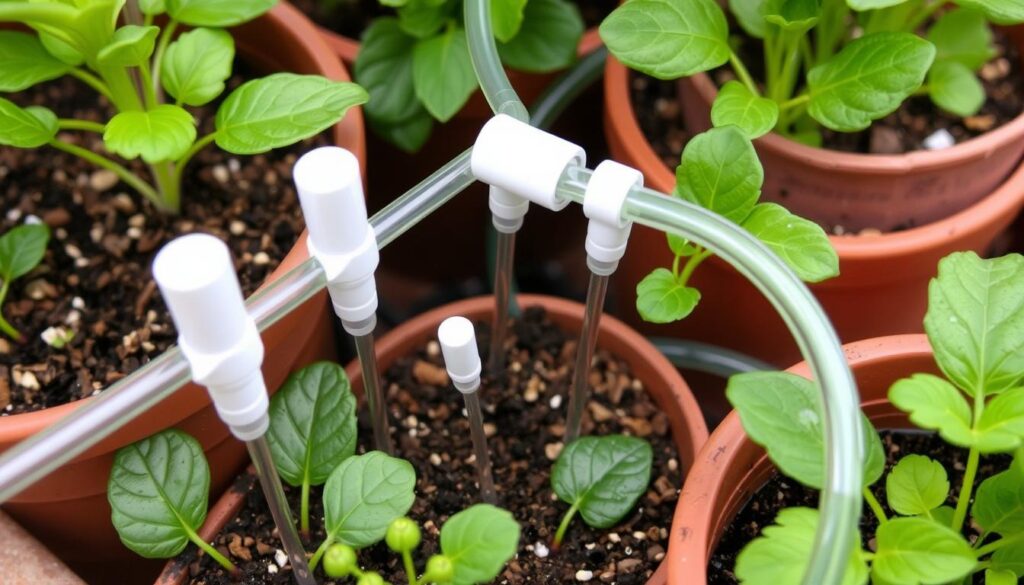
Drip irrigation delivers water precisely where plants need it, reducing waste
Drip vs. Soaker Hoses
Both drip irrigation and soaker hoses offer water-efficient alternatives to traditional sprinklers, but they have different applications in small-space gardens:
Drip Irrigation
- Precision: Delivers water directly to individual plants
- Customization: Can be tailored to different plant needs
- Water savings: Up to 70% more efficient than sprinklers
- Versatility: Works well with containers and raised beds
- Expandability: Easy to modify as your garden grows
Soaker Hoses
- Simplicity: Easier to set up initially
- Coverage: Better for densely planted areas
- Cost: Generally less expensive to start
- Durability: Fewer components that can clog or break
- Limitation: Less precise control over water distribution
For most small-space drought-resistant gardens, a simple drip irrigation system offers the best combination of efficiency and flexibility. Here’s how to set up a basic system for a balcony or patio garden:
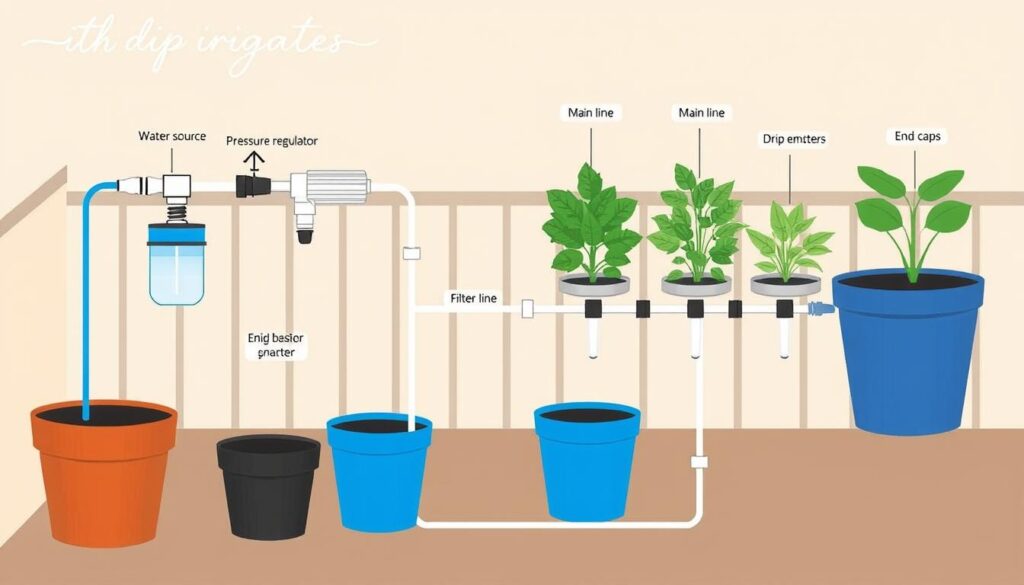
DIY drip irrigation setup diagram with labeled components
- Gather supplies: You’ll need a faucet adapter, backflow preventer, pressure regulator, 1/2″ mainline tubing, 1/4″ distribution tubing, emitters, and end caps.
- Connect to water source: Attach the faucet adapter, backflow preventer, and pressure regulator to your water source.
- Lay the mainline: Run 1/2″ tubing around the perimeter of your garden space.
- Add distribution lines: Connect 1/4″ tubing to the mainline and run it to each plant or container.
- Install emitters: Place appropriate emitters at each plant—1 GPH (gallons per hour) for small plants, 2 GPH for medium plants, and 4 GPH for larger plants.
- Secure and test: Use stakes or clips to secure tubing, then test the system and adjust as needed.
For ultra-small gardens or those without access to a water faucet, consider a gravity-fed drip system. A 5-gallon bucket with small holes drilled in the bottom and connected to drip lines can provide slow, steady irrigation for several days.
Smart Timing
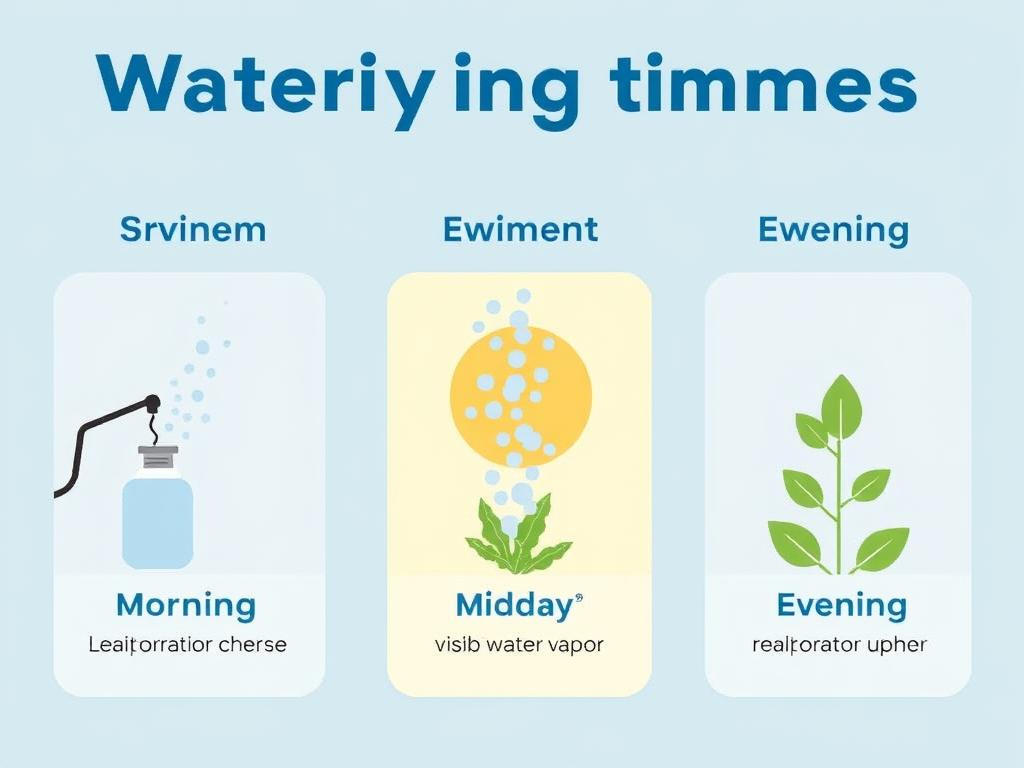
Morning watering (left) results in significantly less evaporation than midday watering (center)
When you water is just as important as how you water. Follow these timing strategies to maximize efficiency:
Optimal Watering Times
- Early morning (5-9 AM): Best time for most gardens
- Late afternoon (4-5 PM): Second-best option, allowing time for foliage to dry before nightfall
- Avoid midday (10 AM-3 PM): High evaporation rates waste water
- Avoid late evening: Can promote fungal diseases
Watering Frequency Tips
- Water deeply but infrequently to encourage deep root growth
- Allow soil to dry slightly between waterings
- Adjust frequency based on weather conditions
- Water new plants more frequently until established
- Group plants with similar water needs together
Water-Smart Tip: For container gardens, the “lift test” is more reliable than a schedule. Lift your containers before and after watering to learn how they feel when properly hydrated. When a container feels light, it’s time to water.
Consider adding a simple timer to your irrigation system to automate watering during optimal times. Even basic battery-operated timers can significantly improve efficiency by ensuring consistent watering when evaporation rates are lowest.
Upgrade Your Watering System
Start with a simple DIY drip system for just one section of your garden. Monitor the results and expand the system as you see the benefits.
Long-Term Maintenance
A well-designed drought-resistant garden becomes more resilient over time, but proper maintenance is key to its long-term success. By monitoring conditions and making timely adjustments, you can help your garden thrive even during extended dry periods.
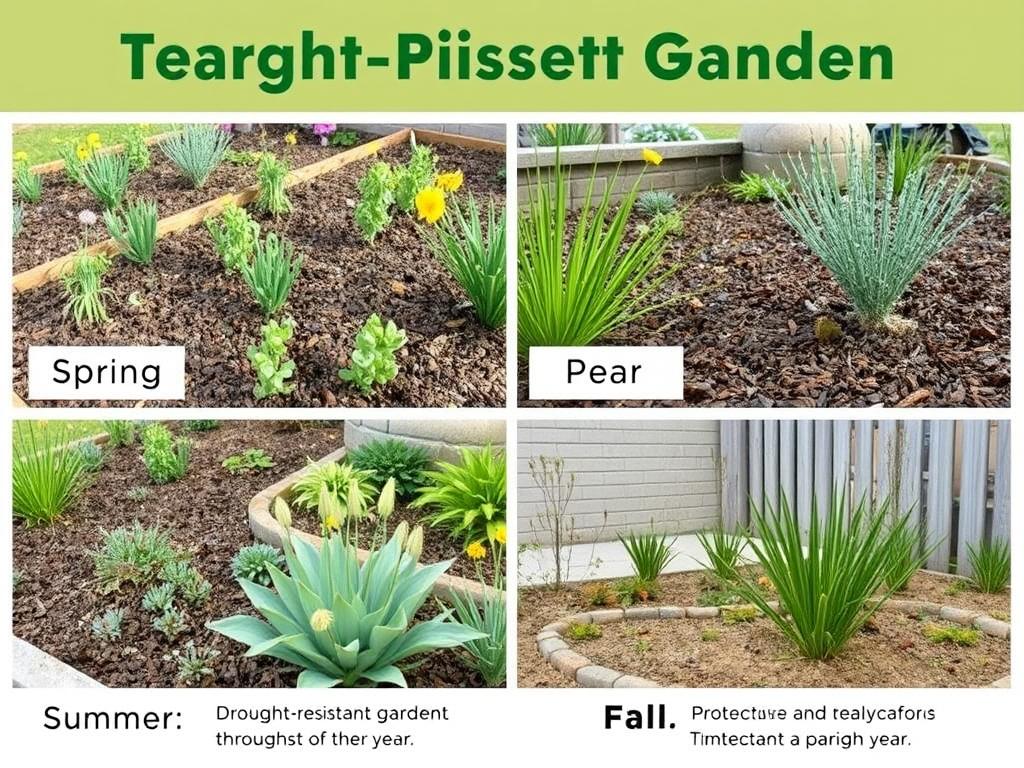
Seasonal maintenance keeps drought-resistant gardens thriving year-round
Monitoring Tools
Knowing exactly when to water is crucial for drought-resistant gardening. These monitoring tools can help you make data-driven decisions:
Moisture Meters
- Digital meters: Provide precise readings of soil moisture at different depths
- Analog meters: Simple, affordable options for basic monitoring
- Placement: Insert probe near plant roots, not in the center of containers
- Frequency: Check every 2-3 days during hot weather
Low-Tech Methods
- Finger test: Insert finger 2″ into soil; if dry, it’s time to water
- Wooden dowel: Insert into soil and check if it comes out damp
- Weight test: Lift containers to feel if they’re light (dry) or heavy (wet)
- Observation: Learn to recognize subtle signs of plant thirst
Smart Technology
- WiFi sensors: Monitor soil conditions and send alerts to your phone
- Weather-based controllers: Adjust irrigation based on local weather data
- Smart timers: Learn your garden’s patterns and optimize watering schedules
- Water flow meters: Track exactly how much water you’re using
For most small-space gardens, a combination of simple observation and occasional moisture meter checks provides sufficient monitoring. As you gain experience, you’ll develop an intuitive sense of when your plants need water based on visual cues and environmental conditions.
Pest Control
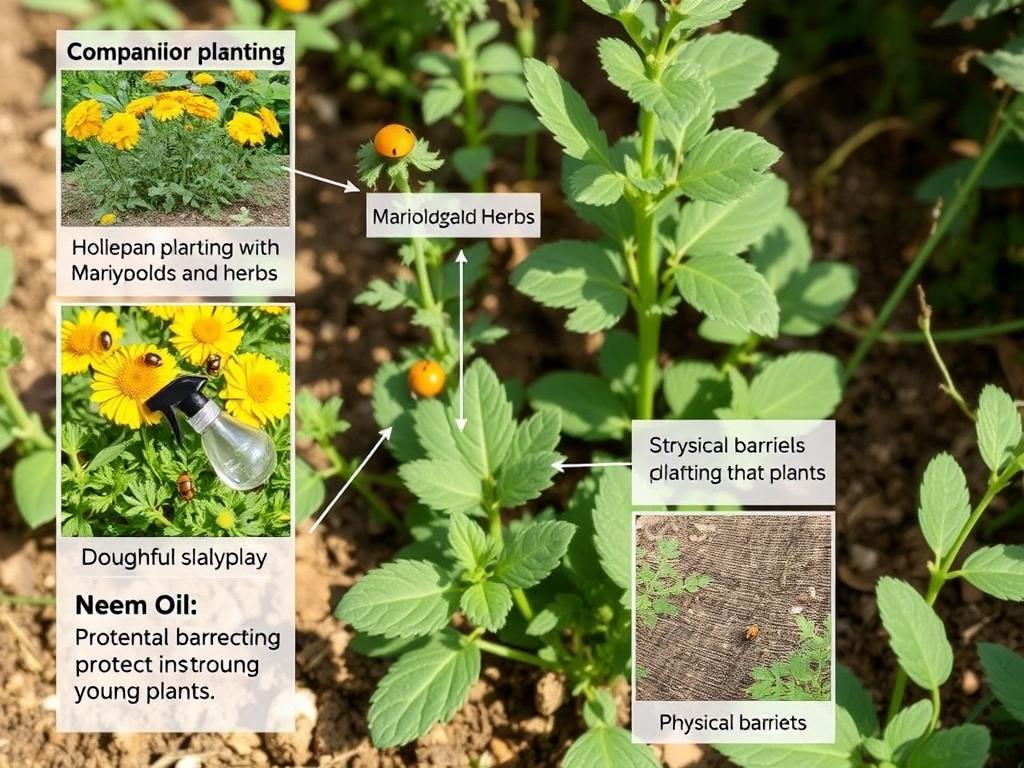
Natural pest control methods complement drought-resistant gardening practices
Drought-stressed plants can be more vulnerable to pests, but chemical pesticides often harm beneficial insects and can disrupt the garden ecosystem. Instead, focus on these natural approaches:
| Pest Control Method | Best For | Application | Water-Smart Benefit |
| Companion Planting | Aphids, cabbage worms, various beetles | Plant marigolds, nasturtiums, and herbs throughout garden | Many companion plants are drought-tolerant themselves |
| Beneficial Insects | Aphids, mites, scale insects | Attract or release ladybugs, lacewings, and predatory mites | Reduces need for water-intensive pest treatments |
| Neem Oil | Wide range of soft-bodied insects | Dilute and spray in early morning or evening | Doesn’t wash away beneficial soil microbes |
| Physical Barriers | Caterpillars, beetles, flying insects | Use row covers, insect netting, or copper tape | Creates microclimate that reduces evaporation |
| Diatomaceous Earth | Crawling insects with exoskeletons | Apply as dry powder around plants | Remains effective without reapplication after light watering |
Regular monitoring is your best defense against pest problems. Inspect plants weekly, paying special attention to the undersides of leaves where many pests hide. Early detection allows for targeted intervention before problems spread.
Important: Even organic pest control products can harm beneficial insects if used improperly. Always apply treatments in the early morning or evening when pollinators are less active, and target only affected plants rather than treating the entire garden.
Seasonal Adjustments
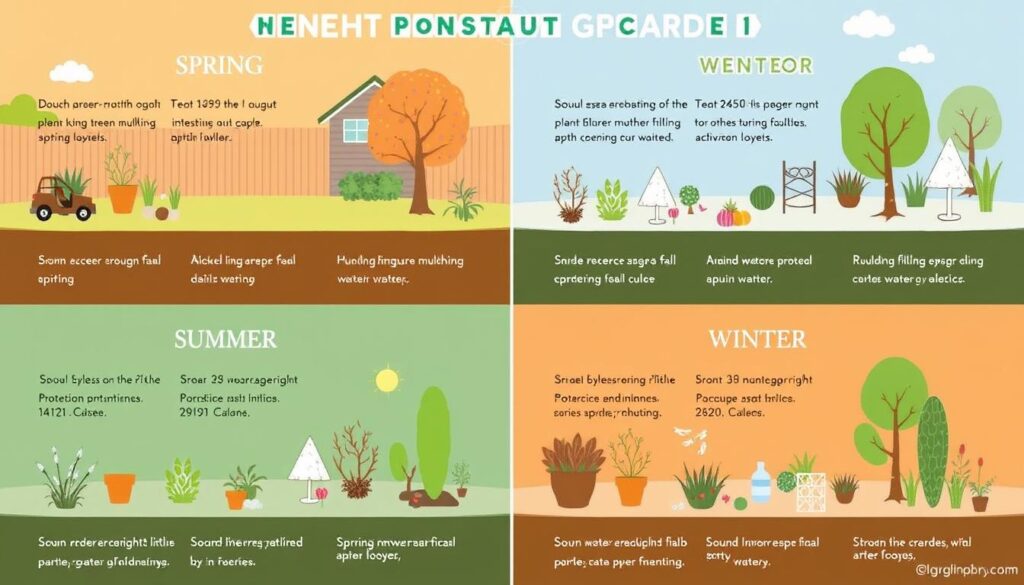
Adapting your drought-resistant gardening practices to seasonal changes
Even drought-resistant gardens need seasonal adjustments to thrive year-round:
Spring Preparations
- Refresh mulch layers to prepare for warmer weather
- Check and repair irrigation systems before peak demand
- Prune winter damage and shape plants before active growth
- Apply compost to replenish nutrients without encouraging excessive growth
- Install shade cloth for afternoon protection of sensitive plants
Summer Maintenance
- Water deeply but infrequently to encourage deep root growth
- Monitor container plants more frequently as they dry out faster
- Harvest regularly from edible plants to encourage production
- Avoid fertilizing during extreme heat periods
- Consider temporary afternoon shade for plants showing stress
Fall Adjustments
- Reduce watering as temperatures cool and days shorten
- Plant new drought-resistant perennials to establish before winter
- Apply a fresh layer of compost to feed soil microbes
- Clean and store seasonal irrigation components
- Collect seeds from successful plants for next season
Winter Care
- Water occasionally during dry winter periods, especially evergreens
- Protect container plants from freezing temperatures
- Plan next season’s garden layout and water-saving improvements
- Order seeds and supplies for spring planting
- Maintain rainwater harvesting systems to capture winter precipitation
Create Your Maintenance Calendar
Develop a simple seasonal maintenance schedule for your drought-resistant garden. Set calendar reminders for critical tasks like mulch refreshing and irrigation system checks.
Conclusion
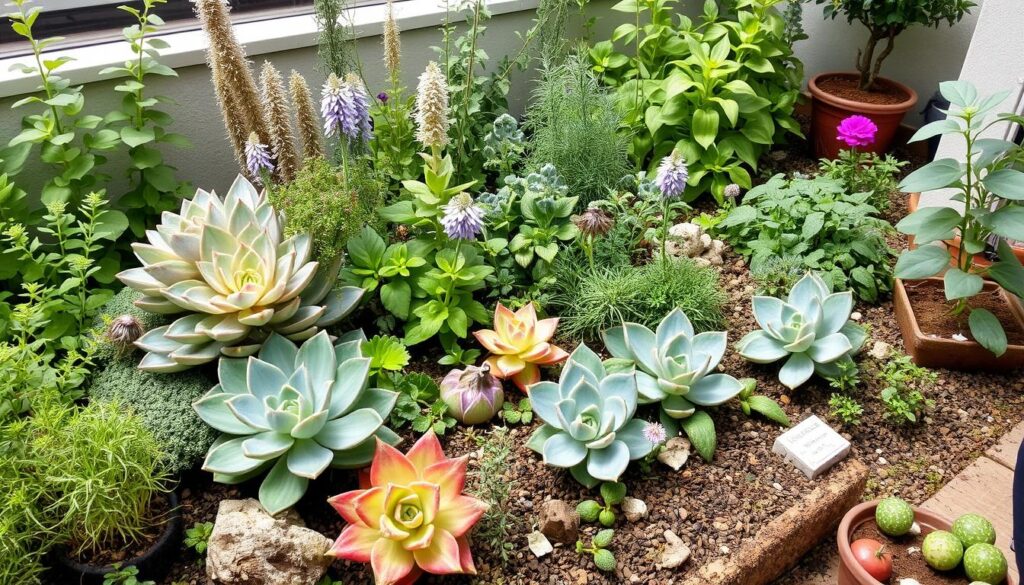
A thriving drought-resistant garden proves that beauty and sustainability can coexist in small spaces
As climate change continues to alter our growing conditions, drought-resistant gardening isn’t just an option—it’s becoming a necessity. The good news is that adapting to these changes doesn’t mean sacrificing beauty or productivity, even in the smallest growing spaces.
By selecting appropriate plants, building water-smart soil, implementing efficient irrigation, and maintaining your garden thoughtfully, you’re creating a resilient system that can withstand challenging conditions. These practices not only help your garden survive during water restrictions but also contribute to broader environmental sustainability by conserving precious resources.
Remember that drought-resistant gardening is a journey, not a destination. Start small with a few containers or a single raised bed, observe what works in your specific conditions, and gradually expand your water-smart practices. Each season brings new opportunities to learn and adapt.
As you implement these techniques, you’ll likely notice benefits beyond water conservation—fewer pest problems, reduced maintenance time, and a deeper connection to natural cycles. Your small-space garden can become a model of resilience and a source of inspiration for others in your community.
“In the face of climate change, our gardens can be either vulnerable victims or powerful examples of adaptation. Drought-resistant gardening allows us to choose the latter, creating beautiful, productive spaces that thrive with minimal resources.”
Take the first step today. Whether it’s adding a drought-resistant plant to your collection, installing a simple drip irrigation system, or beginning to harvest rainwater, each action moves you toward a more sustainable and resilient garden. Your efforts, combined with those of gardeners worldwide, contribute to a more water-wise future for all.
Start Your Drought-Resistant Garden Today
Begin with just one small change. Select a drought-resistant plant, add mulch to your containers, or install a simple rainwater collection system. Small steps lead to significant impact over time.
Will is a vertical gardening enthusiast and sustainable cultivation specialist with a passion for helping people grow fresh food in small spaces and dry climates. With years of hands-on experience testing smart irrigation systems, optimizing urban gardens, and exploring eco-friendly solutions, this author shares clear, practical tips to turn any corner into a productive garden. Whether on a sunny balcony or in a compact backyard, Will helps readers save water, maximize space, and enjoy healthy harvests year-round. When not tending to his plants, you’ll find him sipping herbal tea and sketching ideas for new sustainable projects.

